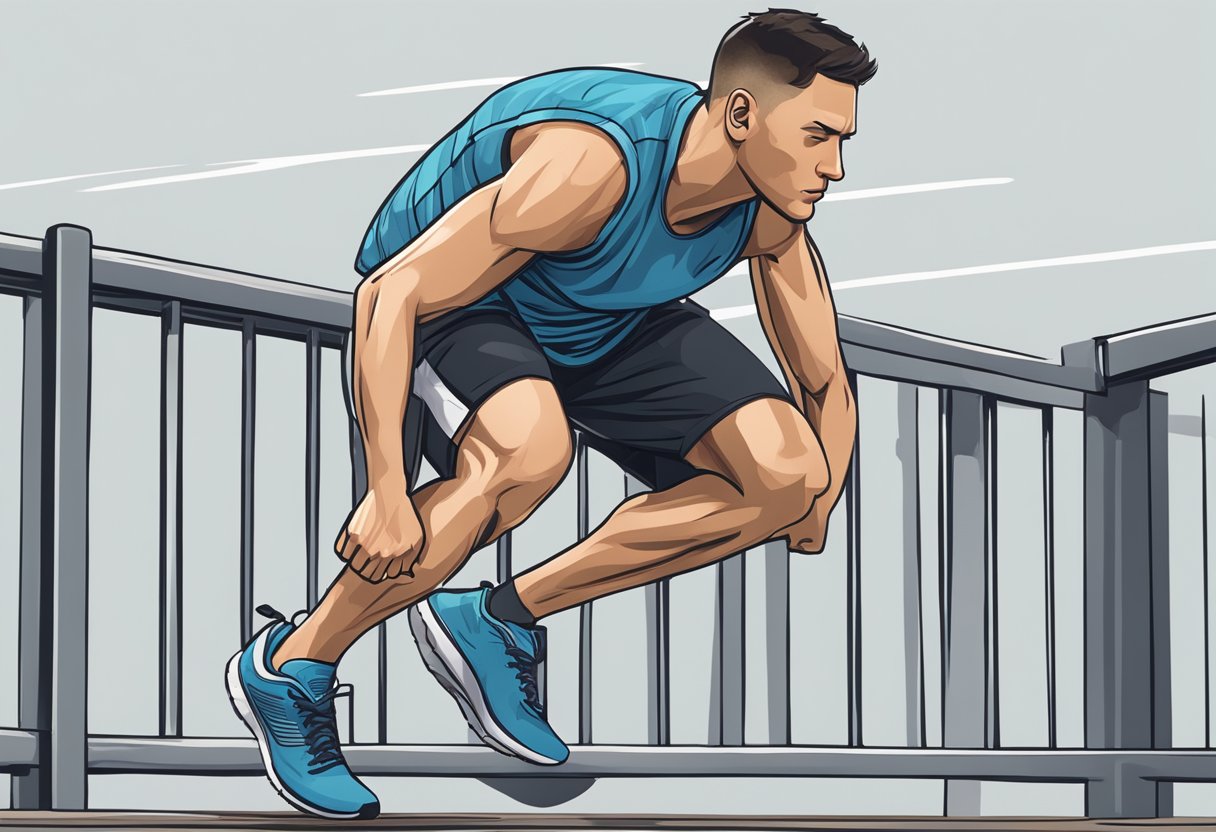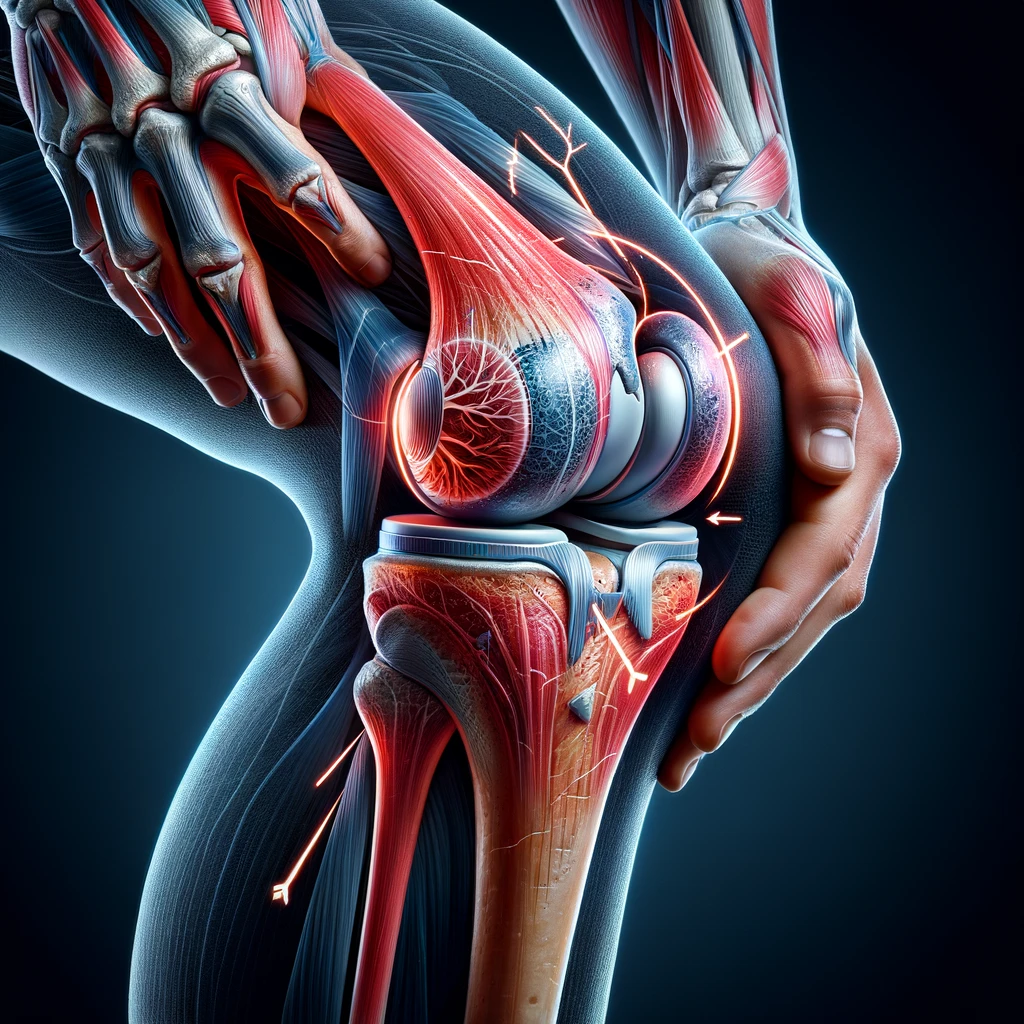Experiencing inside of knee pain after running is a common concern that various factors can cause. Inner knee pain may be temporary discomfort or a sign of an underlying condition that requires attention. To address the issue effectively, it is important to not just treat the pain but understand the potential causes and mechanics behind it.

Your knee is a complex joint with ligaments, tendons, cartilage, and muscles that work together to provide stability and movement. When any of these components are strained or injured, particularly from repetitive activities like running, pain can occur. Understanding the specific anatomy of the knee and how it relates to your running form can help pinpoint what’s causing your pain.
Key Takeaways
- Inner knee pain after running can stem from different causes, including muscle imbalance and overuse.
- Proper diagnosis is crucial for effective treatment and can prevent further injury.
- Maintaining knee health involves balancing treatment, strengthening exercises, and prevention strategies.
Quick Navigation
Inside of Knee Pain After Running: Understanding Knee Anatomy

You must understand the complex structure of the knee to appreciate why you might experience pain after running. The knee is not just a hinge but a sophisticated joint that permits a range of movements.
Components of the Knee Joint
Your knee joint is a pivotal connection between your thigh bone (femur) and your lower leg. This joint includes a variety of key elements:
- The knee cap (patella) protects and provides leverage.
- Bones: The union of the femur, shin bone (tibia), and the smaller fibula.
- Ligaments for stability: the medial collateral ligament (MCL), anterior cruciate ligament (ACL), and posterior cruciate ligament (PCL).
- Hyaline cartilage is a fluid-filled sac known as the bursa that cushions the knee.
- Connective tissue that helps in supporting the joint’s movements.
Each of these components plays a vital role in the efficient function of your knee.
Functions of the Medial Structures
On the inside of your knee are medial structures critical for stability and function:
- The MCL prevents your knee from collapsing inwards.
- Soft tissues and hyaline cartilage reduce friction and absorb shock.
- Ligaments and tendons contribute to stability and movement when running, navigating, or standing still.
Problems with these structures can lead to medial knee pain, which is often caused by overuse or direct impact while active. Understanding these specific functions will help you pinpoint potential sources of pain and address them effectively.
Common Causes of Inside Knee Pain After Running

After a run, you might notice pain on the inside of your knee. This discomfort can stem from various issues, ranging from ligament injuries to overuse syndromes. Understanding the causes is essential to address them better and prevent further knee problems.
Medial Collateral Ligament Injuries
The Medial Collateral Ligament (MCL) is crucial for stabilizing your knee joint. An MCL injury can occur after a forceful impact or a wrong movement during running. Signs include tenderness along the inside of your knee and swelling.
Meniscal Tears and Associated Pain
Meniscal tears are often the result of twisting movements or overuse. The medial meniscus is particularly at risk when you’re running. Pain, stiffness, and swelling can signal a meniscal tear, which can inhibit knee function.
Patellofemoral Pain Syndrome
Often described as runner’s knee, Patellofemoral Pain Syndrome involves discomfort around the kneecap. It can result from the kneecap not tracking properly over the femur due to muscle imbalances or overuse.
Iliotibial Band Syndrome
The Iliotibial Band (IT Band) runs along the outside of the thigh, but issues here can cause pain on the inside of the knee, known as IT Band Syndrome. It occurs when the IT Band becomes tight and inflamed, often from repeated bending and straightening of the knee.
Anserine Bursitis
Anserine Bursitis occurs when the anserine bursa, located on the inner side of the knee, becomes irritated. This condition is common among runners and can cause pain and tenderness just below the joint line of the knee.
Diagnosing Inside of Knee Pain After Running

When experiencing pain inside your knee after running, it’s imperative to receive a proper diagnosis to determine the cause and appropriate treatment. Your healthcare provider or physical therapist will typically begin with a thorough physical examination and patient history, followed by imaging tests if needed.
Physical Examination and Patient History
Your healthcare provider will first conduct a physical examination, assessing the knee for swelling, tenderness, and range of motion. They will inquire about your pain’s nature, duration, and any activities that exacerbate it. It’s crucial to share details about your running habits and any recent changes in intensity or technique, as these can offer important clues. Additionally, discussing any past knee injuries is important for a complete history.
Imaging Tests: MRI and Ultrasound
If the initial assessment doesn’t provide a precise diagnosis, your healthcare provider may order an MRI scan. This imaging test gives a detailed view of the knee’s bones, cartilage, and soft tissues, helping to identify specific issues such as ligament tears or meniscal damage. In some cases, an ultrasound may be used to examine the knee’s soft tissues in motion, offering different insights than an MRI. These imaging techniques can be pivotal in formulating an effective treatment plan.
Inside of Knee Pain After Running: Treatment Strategies for Inner Knee Pain

When you experience inner knee pain after running, addressing it with appropriate and effective treatment strategies is essential. Depending on the severity and nature of your pain, these strategies range from immediate self-care to professional medical interventions.
Rest, Ice, Compression, and Elevation (RICE)
The RICE method is a widely recommended home treatment for managing acute knee injuries, as it helps reduce swelling and pain. Initially, you should:
- Rest: Avoid putting weight on the affected knee to prevent further injury.
- Ice: Apply cold packs to the knee to decrease inflammation and numb sharp pain.
- Compression: Use a knee brace or bandage to apply gentle pressure and provide support.
- Elevation: Keep your knee raised above heart level to help reduce swelling.
Physical Therapy and Rehabilitation
Participating in physical therapy helps to address muscle weaknesses and ensure good form in your movements, which can prevent re-injury. A physical therapist may prescribe:
- Strengthening exercises for improved stability around the knee joint.
- Techniques to improve your running form and reduce stress on the knee.
Inside of Knee Pain After Running: Pain Management and Medication
For immediate relief from severe pain, anti-inflammatory medication can be beneficial. In some cases, your healthcare provider may recommend:
- Over-the-counter pain relievers like ibuprofen or acetaminophen.
- For more intense inflammation, corticosteroid injections may be administered by a medical professional.
Surgical Options
Surgery is usually considered when conservative treatments fail to relieve symptoms and the pain is due to a degenerative condition or structural damage. Potential surgeries include:
- Procedures to repair meniscal tears or MCL injuries.
- Sometimes, an orthopedic surgeon may advise on more complex surgeries like knee replacement for advanced arthritis.
Always seek medical advice before starting a treatment plan, as mismanagement can lead to complications or prolonged recovery.
Inside of Knee Pain After Running: Prevention and Maintaining Knee Health

To combat knee pain after running and promote knee health, you must emphasize proper running techniques, engage in strength training, maintain flexibility, and consider lifestyle factors that influence ergonomics.
Proper Running Techniques and Gear
Running with good form protects the knee joint from common injuries such as runner’s knee or IT band syndrome. Ensure you’re using shoes tailored to your gait and foot structure, such as providing support for flat feet. Consulting a physical therapist is a good idea if you’re experiencing joint pain or muscle imbalances that could affect your running form.
Strength Training and Flexibility
Strength exercises targeting the hip muscles, calf muscles, and surrounding muscles can reduce the risk of muscle weakness and MCL sprains. Incorporate a strengthening exercise for the hamstring muscle to support the knee. Additionally, flexibility is key in preventing sore knees, and a regular routine, including a warm-up, can be a great way to maintain muscle and tendon health, helping to avoid conditions like patellar tendinitis or jumper’s knee.
Lifestyle Factors and Ergonomics
Consider ergonomic factors in your daily life. Sitting or standing for long periods can contribute to dull knee pain among runners. Incorporate regular movement breaks into your day to prevent minor injuries from becoming more significant issues. It is important to be mindful of knee arthritis and plantar fasciitis risks—both conditions benefit from ergonomic considerations in daily activities.
Inside of Knee Pain After Running: Conclusion
Experiencing inside of knee pain after running is a common yet addressable issue. It is crucial to seek immediate relief through methods like RICE and understand and tackle the underlying causes, ranging from MCL injuries to anserine bursitis.
Incorporating a comprehensive treatment approach that includes physical therapy, proper pain management, and, if necessary, surgical interventions can effectively alleviate pain.
Additionally, maintaining knee health through preventive measures such as adopting correct running techniques, strengthening and flexibility exercises, and considering ergonomic factors in daily activities is essential. By addressing the issue holistically, runners can enjoy their sport pain-free, ensuring the longevity of their knee health.

